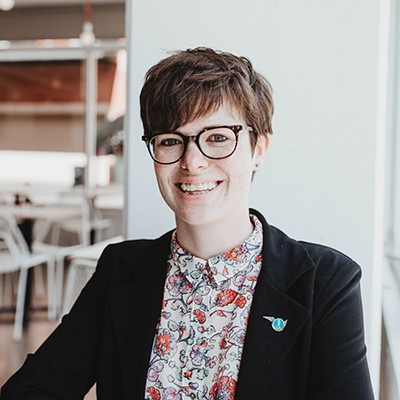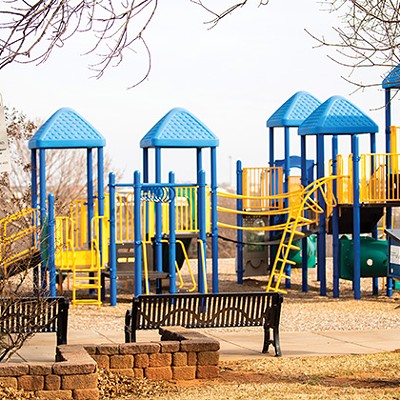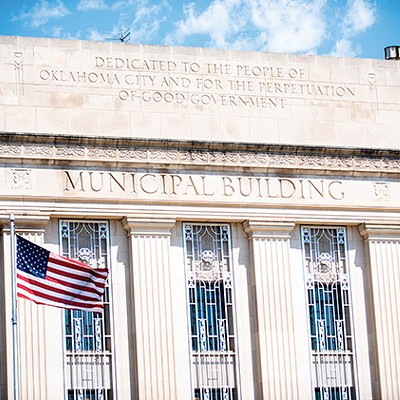
A debate on the project’s route was filled with emotionally charged and often contentious remarks by citizens, community volunteers and elected officials. Almost two dozen citizens spoke against and in favor of the proposal during a 2-plus-hour discussion of the most controversial MAPS 3 project.
After the public comments ended, Mayor Mick Cornett and Councilmen Larry McAtee, David Greenwell, Patrick Ryan and John Pettis, Jr., endorsed the plan. Councilmen James Greiner, Ed Shadid and Pete White voted against the proposal, but all three vowed to help create a top-notch system since the measure passed.
Ward 6 Councilwoman Meg Salyer excused herself from the discussion and vote because she owns property along the route.
Public input
Prior to the vote, council members listened to a plethora of heated public comments — for and against — including some from Patricia Black, who called the streetcar project “Mickey Mouse.” She also suggested the construction of the streetcar tracks will damage the downtown streets that were repaved as part of the $140 million Project 180 renovation project.
Rev. Jesse Jackson, pastor of East Sixth Street Christian Church, 1139 NE Sixth St., favored a route that would take the streetcar to the University of Oklahoma Health Sciences Center and surrounding area instead of areas already served by other means of public and private transportation.
“Economic development already has occurred along the existing route. You need to connect to the health sciences center for the greatest amount of economic development,” he said. “You ought to start with northeast Oklahoma City and connect all those thousands and thousands of people.”
The 4.5-mile route approved by the council will connect the downtown OKC transit center, Automobile Alley, Midtown, Bricktown, the future MAPS convention center and the future intermodal transit hub at the Santa Fe railroad station. The route also will come within a block of the 70-acre MAPS 3 Downtown Public Park.
Garland Pruitt, a resident of east OKC, said a route to the health sciences center would benefit more people.
“Routes can be changed, and at this time, it would be hasty” to approve the recommended route, he said. “We didn’t have a rail system prior to this, so what’s the hurry? We need to expand that route to the medical center. It’s the right decision.”
City officials pointed out the route includes a possible future expansion near the OU Medical Center campus.
Peter Robertson, who lives at 1104 NE Fifth Street, called the recommended route “a plan going nowhere.”
OKC attorney and lifelong resident Elaine Schuster said the route was “poorly planned and poorly designed for the future of Oklahoma City. When you’re serving just this little area, you’re not serving that many people.”
Meanwhile, southwest OKC resident Nancy Anderson said she doesn’t believe the project can stay within the allotted budget. Jacobs Engineering consultants estimate phase 1 project costs between $99 million and $109 million. An extra $2.5 million to $3 million would be spent on annual operating and maintenance costs. At this point, city officials have not determined how they will pay for the operating and maintenance costs.
“We are getting no financial help from those along the route, and there’s no reason to expect large federal grants that other cities have,” Anderson said.
However, Cathy O’Connor, president of the Alliance for Economic Development of Oklahoma
City, said route property owners have expressed interest in helping pay
for the operational costs through a special assessment fee.
“Do they want to pay for all the maintenance? No,” she said.
O’Connor
began meeting with property owners this summer, but it was after the
streetcar subcommittee and the MAPS 3 Oversight Board already approved
the recommended route.
“Aren’t
we like the teenager who mows the yard and then asks to be paid?”
Shadid asked. “Why would anyone want to pay now? They know where the
route is going. This should have been done months ago.”
Meanwhile, other citizens, like developer and businessman Steve Mason, support the route.
Mason acknowledged he owns property and businesses along Broadway Avenue, which will serve as the route’s east boundary.
“I believe the public supports this project,” he said. “Should it be a place maker or a place server? It does both.”
David
Dickerson, a north OKC resident, said he doesn’t expect the streetcar
will come “to [his] front door, but you have to start somewhere.”
Nathaniel
Harding, chairman of the streetcar subcommittee, said the public debate
“was worth it to make the city an exciting place to live.” Harding
believes the streetcar will create a “paradigm shift” in the way OKC
residents “move around the city.”
Flare-up
As
part of the discussion, streetcar subcommittee member Jeff Bezdek (pictured) told
the council that more than 104 meetings were held in the last three
years, leading to “unprecedented public input,” and much of the
criticism leveled at the project was unwarranted.
Later, White made pointed comments about Bezdek’s public participation claim.
“That’s an exaggeration,” the Ward 4 councilman said.
“The
last two meetings I attended were terrible, and there were questions
that were not answered. They were so narrowly focused, and the public
didn’t have a chance to speak. The process wasn’t open.”
Shadid, known for his public criticism of the $128 million modern streetcar project, became embroiled in an argument with Bezdek
over allegations that the subcommittee member tried to manipulate the
consultant selection process in 2010.
As a result, a city auditor questioned Bezdek at the time but found no wrongdoing.
“I went through a period of extreme uncomfortableness while being questioned,” he said.
Speaking
directly to Shadid, Bezdek said, “Since you made this personal, you
have said so many things that are not correct or held up by the facts.
You have railed against the subcommittee and the process, and you have
tried to sabotage a majority-approved vote.”
Mayor’s reaction
Cornett, seeking his fourth term as mayor, was brief with his comments about the contentious meeting.
“There’s
a mayor’s race going on. That’s the short answer,” he said, referring
to Shadid’s own candidacy. “The two highest profile days with a
streetcar system is the day you fund it, which was on election day, and
the day you route it.”
Setting the mayor’s election aside, Cornett wasn’t surprised by the negative reaction to the recommended route.
“There is no such thing as a criticism-free route,” he said.
“If
you actually travel the route, there’s still a lot of land to be
developed. I’m satisfied the subcommittee, the oversight board and the
consultants all did their due diligence, and I have no problem with the
route. But even if you had gone with the health sciences route, you’d
have received criticism.”
Future plans
With
the council’s approval in place, plans call for the consultants to
fine-tune the route with modifications to the Midtown connection. In
addition, the consultants will recommend whether to double-track
Broadway Avenue or form a couplet with Robinson Avenue.
Consultants
from Jacobs Engineering also will make recommendations in connection
with the streetcar propulsion system, the storage and maintenance
facility location, rail and streetcar purchases and development of a
route economic development plan.
The streetcar system is expected to begin operations in 2017.











